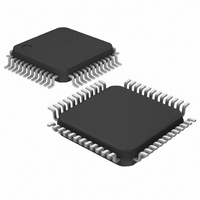MAX9257GCM/V+ Maxim Integrated Products, MAX9257GCM/V+ Datasheet - Page 33

MAX9257GCM/V+
Manufacturer Part Number
MAX9257GCM/V+
Description
IC SER/DESER PROG 48-LQFP
Manufacturer
Maxim Integrated Products
Datasheet
1.MAX9257GTL.pdf
(52 pages)
Specifications of MAX9257GCM/V+
Function
Serializer/Deserializer
Data Rate
840Mbps
Input Type
Serial
Output Type
LVDS
Number Of Inputs
16
Number Of Outputs
1
Voltage - Supply
3 V ~ 3.6 V
Operating Temperature
-40°C ~ 105°C
Mounting Type
Surface Mount
Package / Case
48-LQFP
Lead Free Status / RoHS Status
Lead free / RoHS Compliant
The control channel is used by the ECU to program
registers in the MAX9257, MAX9258, and peripheral
devices (such as a camera) during vertical blanking,
after power-up, or when serialization is disabled.
Control channel communication is half-duplex UART.
The peripheral interface on the MAX9257 can be pro-
grammed to be I
channel is synchronized with the VSYNC input after the
ECU starts serialization of video data. Programmable
timers, ECU signal activity, and end frame determine
how long the control channel stays open. The control
channel remains open as long as there is signal activity
from the ECU. When the control channel closes, the
LVDS serial link is reestablished. Once serialization is
enabled, the programming of registers (including the
control channel overhead time) must be completed
within the vertical blanking time to avoid loss of video
data. VSYNC can deassert while control channel
remains open after eight pixel clock cycles.
The control channel phase begins on the transition of
the programmed active edge of VSYNC_IN. In video
applications, the VSYNC signal of the peripheral device
is connected to VSYNC_IN on the MAX9257. In other
applications, a different signal can be used to trigger
the control channel phase. When the MAX9257/
MAX9258 detect the VSYNC_IN transition, the LVDS
video phase disables and the control channel phase is
enabled.
The control channel operates in two modes: base and
bypass. In base mode, the ECU issues UART com-
mands in a specified format to program the
MAX9257/MAX9258 registers. GPIO on the MAX9257
are also programmed in base mode. UART commands
are translated to I
connected to the MAX9257 when not addressed to
either the MAX9257 or the MAX9258.
In bypass mode, programming of the MAX9257/
MAX9258 registers are temporarily or permanently
blocked depending on the programmed value of CTO.
Blocking prevents unintentional programming of the
MAX9257/MAX9258 registers when the ECU communi-
cates with the peripheral using a UART protocol differ-
ent than the one specified to program the MAX9257/
MAX9258. When the control channel is open, the
MAX9258 continues outputting the pixel clock while
HSYNC and video data are held at the last value. If
spread is enabled on the MAX9258, the pixel clock is
spread.
Fully Programmable Serializer/Deserializer
Overview of Control Channel Operation
2
______________________________________________________________________________________
C or UART. Operation of the control
2
C and output to peripheral devices
Control Channel
with UART/I
Control channel overhead consists of lock frame, short
synchronization sequence, and error frame. The lock
frame is transmitted between the MAX9257 and the
MAX9258 without action by the ECU. The error frame is
only sent in response to end frame. When MAX9257
spread spectrum is enabled, the control channel is
entered after spread reaches center frequency. The over-
head from VSYNC falling edge to control channel enable
accounts for a maximum of 1400 pixel clock cycles.
Base mode allows the ECU to communicate with the
MAX9257/MAX9258 in UART and a peripheral device in
I
possible in base mode. UART packets from the ECU
need to follow a certain protocol to program the MAX9257
and the MAX9258 (Figures 28 and 29). Packets not
addressed to the MAX9257/MAX9258 get converted to
I
The MAX9257 receives I
device and converts them to UART packets to send back
to the ECU. To disable communication to the peripheral
device, write a 0 to INTEN (REG8[6] in the MAX9257 and
REG7[6] in the MAX9258).
In base mode, the STO/ETO timers and the EF command
are used to control the duration of the control channel.
STO and ETO count up and expire when they reach their
programmed value. STO and ETO are not enabled at the
same time. STO is enabled after CCEN goes high. If there
is activity from the ECU before STO times out, STO is dis-
abled and ETO is enabled. The ECU must begin a trans-
action within an STO timeout or else the channel closes.
The ECU can close the channel by allowing ETO to time-
out. Activity from the ECU resets the ETO timer. Another
way to close the control channel is by sending an end
frame (EF). EF closes the channel within 2 to 3 bit times
after being received by the MAX9257/MAX9258. The
default value of EF is 0xFF, but can be programmed to
any other value besides the MAX9257 and the MAX9258
device addresses. The control channel must be closed
with EF for control channel errors to be reported.
Program STO to be longer than the time the ECU takes
to respond to opening of channel. Program ETO to be
longer than the time the ECU pauses between transac-
tions. As long as the ECU performs transactions, ETO is
reset and the channel stays open.
The ECU must wait 14 or more bit times before address-
ing another device during the same control channel ses-
sion. Failure to wait 14 bit times may result in the packet
boundary not being reset. Internal handshaking opera-
tions are automatically performed after the channel is
closed and before the video phase begins.
2
2
C. UART programming of the peripheral device is not
C by the MAX9257 and pass to the peripheral device.
2
C Control Channel
2
C packets from the peripheral
Control Channel Overhead
Base Mode (Details)
33











